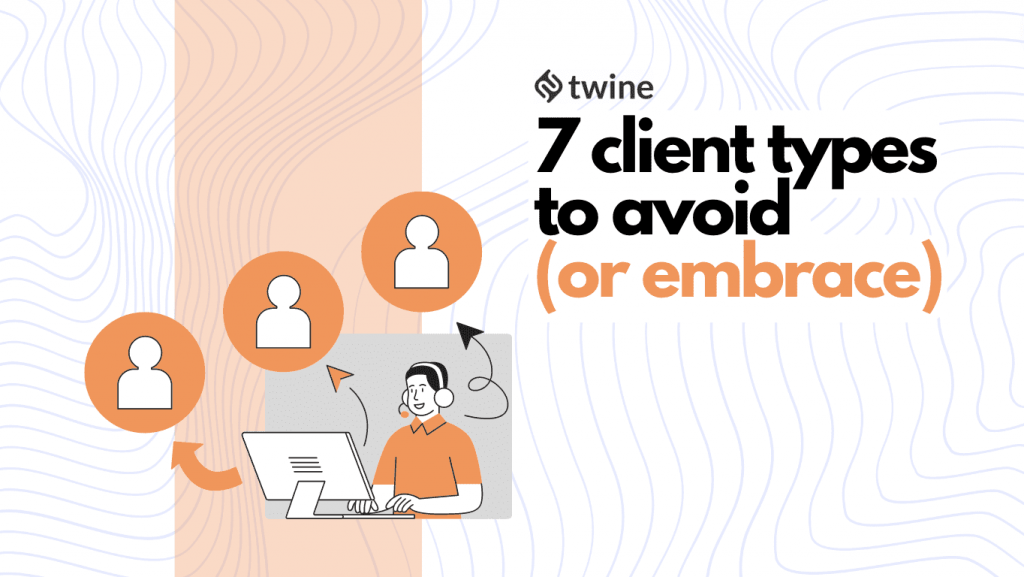
For more Networking Tools, check out the Freelancer Toolkit…
Freelancers of all levels would agree that getting their first paycheck was the hardest thing they’ve ever had to do. In fact, many have abandoned their dreams of being modern-day digital mercenaries because they never even met their first client and didn’t know the different client types…
But it gets easier after you get some good feedback and a couple of references. Somewhere down the line, you will get to a point in your career where you can pick and choose who you work with. That’s when the second most difficult challenge appears—avoiding nightmare clients.
Some projects aren’t worth the trouble no matter how high the pay rate gets. On the other hand, there are clients that are a joy to collaborate with in any scenario. Sadly, those are few and far in between.
Are you a freelancer looking for new opportunities? Let us help.
Why Is It Important To Be Able To Identify Client Types?

Being able to distinguish between employers that hire remotely can make or break your freelancing career as well as your mental health.
If you get this part right, you will maintain a great work-life balance and avoid overworking yourself. But, if you fail to recognize different client types, you risk spending far more time working on far less lucrative contracts. To add insult to injury, you’ll most likely get a negative review as well, regardless of your efforts to please the client.
Let’s discuss some prominent client types. Some that you should avoid, or at least be prepared to deal with, and some that you’ll actually want to work with forever.
1. The Tight-Budget Client

Tight-budget clients, or penny-pinchers, as I like to call them, are by far the most common type of client that you will encounter. Luckily, they aren’t that hard to deal with, and you’ll usually have a pleasant time working with them if you ignore the fact that your compensation is less than ideal.
These are almost always start-ups or individuals looking to launch their own business. Funny enough, if you’re a designer or a writer, your common low-budget clients will be other freelancers setting up their portfolio websites.
Finally, tight-budget client types always put special emphasis on getting a quote from you before they even properly describe the scope of work. This is their primary giveaway.
Pros:
- Great for getting more clients under your belt and building a huge portfolio
- Projects are usually not very demanding skill-wise
- It’s quite simple to get them to work with you – just lower your price a bit
Cons:
- They might haggle with you, which is never pleasant
- Cutting costs at some point and leaving you with a lower budget to complete your work
- May ask you to do more than what you agreed upon midway during the project
Dealing with tight-budget client types is all about setting up a pre-existing agreement that both sides are happy with. You can’t stop them from haggling, but don’t sell yourself short and never agree to work for less than what makes you comfortable. Also, clearly define what you’re working on and stay within those boundaries.
If you accept additional work for the same amount of money, they won’t hesitate to exploit that fact.
You can also recommend creative solutions that will free up some of their budget for the project. Then, the client will be more inclined to pay you your standard rate and also remain eternally grateful, as cutting costs is their number one priority at all times.
2. The High-Maintenance Client

Have you ever been in a relationship in which the other side simply won’t leave you alone for even a few minutes? They not only need your constant attention, but also want to know where you are and what you’re doing at all times. It gets real old, real fast.
That’s what working with a high-maintenance client feels like. They will not be afraid to call you on the weekend to check on your progress or to text you three times if you do not respond immediately. Take care, as working with this client may turn out to be the biggest mistake of your freelancing career.
Regardless, these folks usually pay well, pay on time, and have exciting projects you will enjoy working on. However, you need to be prepared to deal with the additional pressure if you decide to work with needy client types.
Pros:
- Clear expectations regarding project scope
- Contracts usually pay well and might include generous tips
- Lack of communication can never be a problem here
Cons:
- You may find their aggressive nature extremely stressful
- Their constant need to check on your progress might lead you to feel they believe you’re not doing a good job (this is usually not true)
- Some freelancers prefer being left alone until the entire project is done and will find constant back and forth with the client quite unpleasant
Thankfully, there are some pretty neat ways to deal with a high maintenance client.
First, you need to communicate your boundaries. This is brilliant advice for pretty much anything in life, but essential to work relationships. Your employer needs to know about what times you are available for discussion, how often you can update them on your progress, and when you’re usually offline. If they ignore this information, you can then ignore their messages until you’re back working again.
Next, I’d recommend setting up a progress tracker. For example, you can divide the project into multiple milestones and create a Google Spreadsheet with tiny little checkboxes. Once you’re done with each milestone, just check it off the list and perhaps write a note mentioning anything you think the client might be interested in. This way, they can keep track of your progress in real time and will not feel the need to message you so often.
Last but not least is my favorite trick when dealing with high-maintenance client types. Give them a taste of their own medicine. Whenever you make a bit of progress that you don’t think is even relevant, send them an update describing in detail what you have done. Do this often, and you might dissuade them from bothering you when you’re busy otherwise.
3. The Vague Client

Now here’s a client that won’t haggle with you, micromanage your work, nor persistently phone you during the night. And boy, you’re going to wish they would.
At first, it may seem like a vague client gives you a lot of creative freedom because they won’t share any specific expectations regarding how they want the job done. It may appear that you have struck gold.
Then, once you turn in your work, they’ll say it’s not what they were expecting and ask for a revision. In some scenarios, you’ll get stuck in this endless loop of revisions, trying to figure out what the client wants from you.
No matter how hard you try to get them to explain their needs or give you more detailed feedback, you won’t be able to do so. Personally, this is my nightmare client, and I’d rather work with a high-maintenance person any day of the week.
Pros:
- Usually pays well
- You will have “creative freedom”
Cons:
- They will ask for infinite revisions if given the chance
- You’ll grow extremely frustrated by the lack of feedback and communication
- Closing the contract might take weeks or even months
Whenever a job feels too good to be true, that’s possibly a vague client in disguise. To confirm your suspicion, you can ask for specific job requirements before you accept the contract and see what they come up with. If this causes them to refuse working with you, then you just dodged a bullet.
Also, limit (severely) the number of revisions you offer. This way, they are going to have to think twice before they refuse your work without giving you proper feedback.
4. The ‘Final Boss’ Client

Here, in the middle of our article, we reach the worst imaginable client any freelancer could come across. They have in themselves a bit of all the client types described above, along with some bonus negative quirks as a cherry on top.
For example, an overall difficult client will try very hard to get you to lower your rates, then micromanage your work and finally say they aren’t happy with the results without giving you proper feedback. You can also expect them to be mean, condescending, forgetful, and petty. The list goes on.
If you’re working at a freelancing site where they can leave a review for you, you’ll get a maximum of 3 or 4 stars, even if you complete the job perfectly without any hiccups. I’d even go so far as to say that you should avoid these clients even if you are really desperate for a job. Nothing good ever comes from working with the Final Boss.
Pros:
- Literally nothing – you will come out of this contract scarred for life
Cons:
- They don’t pay well, assuming they pay at all
- They have no idea what they want, but know what they don’t want (and it’s your work)
- You will receive a negative review at worst, and a middling one at best
This last paragraph usually describes how to recognize and deal with each client type. However, dealing with the Final Boss is impossible, so I’ll keep it short and focus on teaching you how to recognize them.
Upon first contact, they will tend to act extremely arrogant. They will ask you for previous examples of your work but won’t tell you if they liked it or not. They’ll just move on to the next topic. They’ll ask for a quote, and even if you say the project cost is one dollar, they’ll counter offer fifty cents.
The best way to recognize them is to know that these are usually low-ranked individuals within a big company that are extremely unhappy with their jobs. They don’t personally care about the project results and likely see freelancers as people they can take their frustration out on. Look at their employment history and perhaps decide to stay away.
5. The Long-Term Client

I don’t know about reading, but writing that last one was stressful and it brought up some repressed feelings and memories. Luckily, we’re moving on to some more positive client types.
The long-term client is your bread and butter as a freelancer. Sometimes, getting new contracts can be tough, and because of that, you don’t feel quite secure financially. However, these repeat client types solve this problem and help you finally get rid of that common freelancer anxiety.
Pros:
- Regular income and never going out of work
- Connecting with someone who is in position to offer you more jobs in the future
- Clear understanding of project goals and the client’s vision
Cons:
- If you focus on one client only, you’ll become dependent on them
- You may feel bored or burned out if the project is not diverse enough
Maintaining a positive relationship with a long-term client is crucial if you want them to stick around. You simply need to focus on transparency and communication. This is a client you might end up working with for years to come, so try to consider them a friend instead of just another employer. Also, show them how you are trying to understand their goals and preferences and they will appreciate it.
In the end, one of the most important goals for any freelancer is to turn regular clients into repeat ones. If working with you was a great experience for them, your work ethics are impeccable, and you showed a genuine interest in their project, most of your clients will come back for more. Over time, this will help you build a network of long-term clients and guide you to financial stability.
6. The Hands-Off Client

The vague client from one of the previous sections is the evil twin of the hands-off client. This person is everything you hoped the vague client would be. They will give you only some basic requirements, and you will have infinite creative freedom with the rest.
Once you deliver, they will be happy with your work (as long as it’s high-quality) and praise your ideas and creativity.
Keep in mind that some clients may be hands-off with most aspects of your project but decide to involve themselves in others. In my experience, they do this when they have true expertise in a specific area, and you should listen to their advice.
Pros:
- Actually appreciates your ideas
- Available for feedback at all times but won’t bother you while you’re working
- Potential for building a long-term relationship
Cons:
- Expectations aren’t always clearly defined
- Might ask for a small revision or two, but you shouldn’t find this inconvenient
The initial tells of a hands-off client are similar to those of a vague client. However, you will notice they are more communicative and usually have an outstanding personality to match. It’s really a case of good twin / evil twin. Use your best judgment to discern between the two.
Out of all the client types, this one is most likely to turn into a repeat client if you build a good relationship with them. Focus on meeting their goals, being available, and delivering high-quality work. You’ll have another long-term client on your hands in no time.
7. The Dream Client

I was lucky enough to work with a couple of dream clients during my freelancing career. The first one introduced me to the world of link building and SEO, which became my secondary skill set. I ended up taking on a full-time role with the other one.
The ideal client will be quite communicative, and you will like them as a person from the very beginning. They will show genuine interest in your previous work and discuss it with you. They won’t try to haggle with you, but will instead give you an offer that’s better than your standard rates.
Dream clients will be very upfront about their expectations for the job, but will at the same time respect your artistic license. In case they want you to make some changes once the project is done, they’ll give you detailed feedback and try their best to explain exactly what you need to revise.
Pros:
- Higher pay than expected
- Clear job requirements
- Creative freedom
- Great communication
- Potential long-term relationships
Cons:
- None
I noticed I shared a lot of common interests with my previous dream clients, so it’s quite possible that everyone’s ideal client is different. Try to deliver your best work to them, and you might end up with a friend, a mentor, and near-infinite work opportunities in the future.
Conclusion
While freelancing can be a rewarding and fulfilling experience, it also comes with its own set of challenges. Understanding different client types and their characteristics can help you navigate these waters and maintain a healthy work-life balance.
Every one of these client types presents its own set of problems you have to solve. By being aware of the different kinds of clients you have, you can be better prepared for what to expect and come up with ways to handle them well. It’s also crucial to remember that not all clients will fit into one specific category, and some may have characteristics of multiple client types. A long-term client may also be quite vague, and a hands-off client may have a tight budget.
Ultimately, the most important thing is to always maintain a professional attitude, set clear expectations and boundaries, and communicate effectively with your clients.



